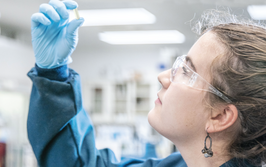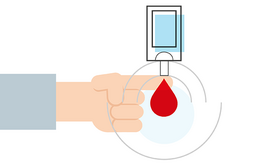
Inside the World’s Most Expensive Pharmaceutical Market
Costs in the US have doubled for almost half of top-selling branded medicines over the past six years.
The sky-rocketing prices of drugs in the US have been highlighted to a global audience in recent months; the price hikes of much-needed drugs, such as insulin and Humira, have become the subject of much debate. With a single vial of Humalog, a branded version of insulin, costing $274 in 2017 (1), many Americans are priced out of access.
“While high prices are of no benefit to the average citizen, they are even worse for the 12 percent of adults who fall into the category of being uninsured or underinsured. These patients pay based on the list price of the drug, and not on the “true,” post-rebate prices. As the gap widens between list and post-rebate prices, these patients pay disproportionately more,” says Nathan Wineinger, Director of Biostatistics and Assistant Professor at Scripps Research.
Wineinger is first author of a paper recently published in The Journal of the American Medical Association that outlines the growing trend for inflated Rx drug prices in the US (1). In their evaluation of 49 common top-selling branded drugs, the researchers found that 78 percent of the drugs that have been available since 2012 have seen an increase in insurer and out-of-pocket costs by more than 50 percent, and 44 percent have more than doubled in price.
Previous research has found that the prices of top-selling branded drugs in other developed nations pale in comparison to the US where, spending on drugs per capita is anywhere between 54 and 209 percent higher than other high income countries (1).
“Legal protections grant large pharmaceutical companies market exclusivity and limit competition. The fact that US law prevents adequate negotiation against these high costs also contributes to the US’ unmatched drug pricing policies,” explains Wineinger.
Rx spending per capita
Organization for Economic Co-operation and Development, 2017.
| Countries | Rx Spending per Capita |
| Sweden | 351 |
| Norway | 401 |
| Netherlands | 417 |
| Australia | 427 |
| United Kingdom | 497 |
| France | 553 |
| Canada | 669 |
| Germany | 686 |
| Switzerland | 783 |
| United States | 1011 |
The US experienced record levels of growth in drug pricing between 2014 and 2015 as several innovative products made their way to market. Though spending slowed in 2017 due to lower price increases for protected branded products, net pharmaceutical drug spending still reached $324 billion (2).
As manufacturing volumes increase and the research conducted on currently available branded drugs is scant, how are the prices being justified? Some industry players and advocacy groups argue that lowering drug prices would have a knock-on effect on R&D, impinging on the US’ capacity to back innovative research. But Wineinger disagrees. “The contention that excessively high prices and spending are necessary to foster innovation has not been shown to be true,” he says. “Public funding of research substantially contributes to the development of new products. Yet the notion that there would be a drastic drop in innovation in the event of cutting drug prices seems to be widely held.”
Peter Bach, Nancy Yu and Zachary Helms, all based at the Memorial Sloan Kettering Cancer Center, empirically tested the claim that premiums earned from charging US patients and taxpayers more for medications than other western countries fund research. They found that the premiums earned were substantially higher than the amount spent by companies on R&D (3), meaning there are billions of dollars not being invested back into research.
Another issue associated with US drug pricing is the impact of US patents, which reduce competition from generic drugs. Drug patents filed in the US are granted exclusivity rights for 20 years from the date of application and the FDA extends a five-year period of exclusivity for any NCE, even if it lacks patent protection. Many drugmakers also take advantage of the opportunity to extend their exclusivity rights, monopolizing the drug patent sector and blocking the introduction of more affordable generic products.
“When generics enter the market, the overall cost of specific drug products drop as competition increases,” says Wineinger. “However, manufacturers may take advantage of patent laws to extend the exclusivity of a product, maintaining high costs. The original patent for Humira, the number one selling product in the world, expired in 2016. Yet biosimilars will not be available until 2023 due to patent extensions.”
Recently, the Trump Administration has moved to enforce drug list pricing in TV adverts, but will it make a meaningful difference? Wineinger thinks that much more needs to be done. “Health is an inelastic right for all, or at least it should be. Patent laws need to be revisited to bring about impactful change,” he argues. “We also need greater negotiating powers so that the economic and clinical value of pharmaceutical products can be thoroughly assessed. What we pay as a society should be proportional to the inherent value of a given product.” In May, the House of Representatives in the US passed several bipartisan bills to lower drug prices. The aim of these bills was to allow the American public better access to affordable and generic medications and prise away some of the influence that manufacturers of branded drugs have over the industry. But it is not believed that the bills will make it through the Senate because they lack enough Republican support, mainly due to the fact that the bills also include provisions to bolster Obamacare.
- NE Wineinger, Y Zhang , EJ Topol. “Trends in Prices of Popular Brand-Name Prescription Drugs in the United States.” JAMA Netw Open. (2019).
- IQVIA, “Medicine Use and Spending in the U.S.: A Review of 2017 and Outlook to 2022.” Available at: bit.ly/2ISnzIS. Last accessed: June 28, 2019.
- Health Affairs Blog, “R&D Costs For Pharmaceutical Companies Do Not Explain Elevated US Drug Prices.” Available at:https://bit.ly/2XfNQtq. Last accessed: June 28, 2019.
After finishing my degree, I envisioned a career in science communications. However, life took an unexpected turn and I ended up teaching abroad. Though the experience was amazing and I learned a great deal from it, I jumped at the opportunity to work for Texere. I'm excited to see where this new journey takes me!


















